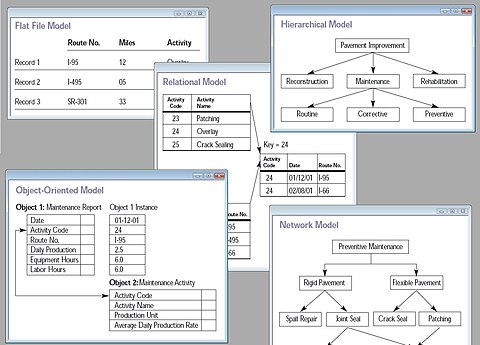Database model
A database model is the theoretical basis for a database and determines the structure in which data is stored in a database system. The best known and most common database model is the relational database model , which is table-based .
definition
According to Edgar F. Codd , a database model is defined by three properties:
- a generic data structure that describes the structure of a database. Example: a relational database consists of relations with unique names, each relation is a set of tuples (data records) of the same type. The structure is generic insofar as the relations and their attributes (columns) can be chosen as desired or must be specified when setting up the database. This application-specific structures form the major part of the schema of the database.
- A set of generic operators that can be used with any scheme on the data structures under 1. to enter, change, query or derive data.
- A set of integrity constraints that can be used to further restrict the permitted database contents beyond the basic structures under 1.. In the relational database model, B. each attribute of a relation can be determined as unique; then two tuples of this relation cannot have the same value in this attribute. Changes in the database that would violate the integrity constraints are rejected with an error message.
Examples
Well-known database models, which are mainly based on the methodology used in software development (e.g. the object-oriented paradigm ) and the intended database technology, are:
- Hierarchical database model
- Network database model
- Relational database model
- Object-relational database model
- Object-oriented database model
- Document-oriented database model
See also
literature
- EF Codd: Data models in database management , Proceedings of the 1980 Workshop on Data Abstraction, Databases and Conceptual Modeling, Volume 11, 16 Issue 2, 74, 1
- Alfons Kemper, André Eickler: Database systems. An introduction. , Oldenbourg, Munich 2004, ISBN 3-486-27392-2
- G. Saake, I. Schmitt, C. Türker: Object databases - concepts, languages, architectures , Bonn, 1997, ISBN 3-8266-0258-7
